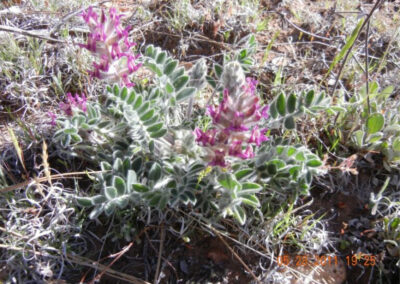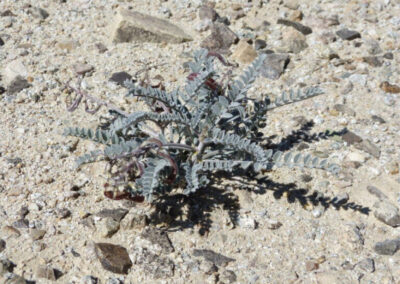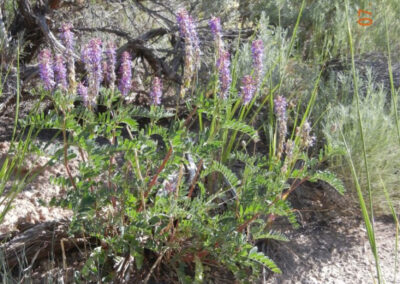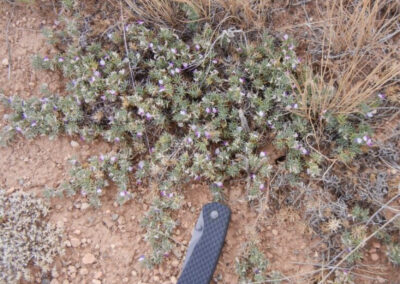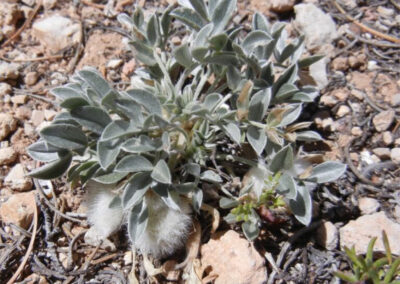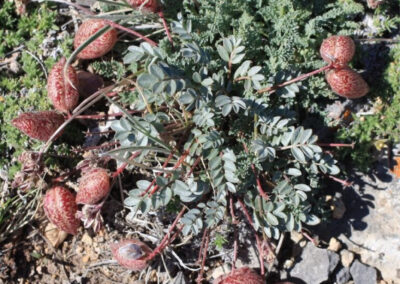Research
What we do
My lab uses phylogenetic approaches to understand the systematic relationships and the evolutionary history of plants; some of our recent projects are described below. Our focus of interest is the legume family (Fabaceae or Leguminosae), whose agricultural, ecological and economic importance to humans is unparalleled among angiosperms. Legumes constitute a large (c. 770 genera and >19,500 spp.; Lewis et al., 2005; LPWG, 2017), cosmopolitan, morphologically and ecologically diverse clade with species that are found in nearly every biome on Earth. Many species play a key role in terrestrial biogeochemistry via the fixation of atmospheric dinitrogen by forming symbioses with root-nodulating rhizobial bacteria. Included among the familiar legumes are the wattles, mesquites, peanuts, locoweeds, peas, alfalfa, beans and soybeans, as well as model genetic/genomic species. An abundant and continuous fossil record indicates legumes have been present since the early Paleocene (66-60 Ma).


And lately, my lab has been exploring the genomics of cacti, beginning with sequencing the genome of the saguaro cactus, Carnegiea gigantea. Cacti, which are native to the New World (with 1-2 exceptions) exhibit some of the best examples of adaptations to extreme – hot, dry (arid) – environments found among land plants. Cacti are also among the most threatened with extinction of plant groups due to high anthropogenic pressures on biodiversity in arid lands, as well as the unscrupulous collection of live plants for private collections and horticultural trade. Shown here are examples of saguaros (SGP4, left, and SGP5, right) we sampled for our studies growing near the Desert Laboratory on Tumamoc Hill, in Tucson, Arizona.
Phylogenetics and diversification of papilionoid legumes
Papilionoideae (“papilionoids”) constitute the most species-rich and widely distributed of the six subfamilies of legumes with an estimated 14,000 species in ~503 genera (Lewis et al., 2005; LPWG, 2017). Papilionoids are well known for their agricultural importance, as they include many of the major crops such as beans (Glycine, Phaseolus, Vicia), lentils (Lens), peas (Pisum) and chick peas (Cicer), and the forage crop alfalfa (Medicago sativa), most of which are cultivated worldwide.
Variation in floral architecture across the papilionoid legumes. Selected taxa represent genera from the early-branching lineages (A–M) and the NPAAA clade (N-O). (A) Swartzia acutifolia, Swartzieae clade; (B) Castanospermum austral, ADA clade; (C) Dipteryx magnifica, ADA clade; (D) Myrocarpus fastigiatus, ADA clade; (E) Pickeringia montana, Cladrastis clade; (F) Harpalyce brasiliana, Genistoid s.l. clade; (G) Aldina latifolia, Andira clade; (H) Exostyles venusta, Exostyleae clade; (I) Dermatophyllum secundiflorum (Genistoid s.l. clade; (J) Dalea mollis, Dalbergioid s.l. clade; (K) Centrolobium microchaete, Dalbergioid s.l. clade; (L) Leptolobium dasycarpum, Genistoid s.l. clade; (M) Lupinus sericeus, Genistoid s.l. clade; (N) Robinia neomexicana, NPAAA clade; (O) Astragalus mollissimus, NPAAA clade. Photos by D. Cardoso and M. F. Wojciechowski. Fig.1, Choi et al., Frontiers in Plant Science (2022)
While the Papilionoideae traditionally have been diagnosed by several morphological synapomorphies, the most distinctive morphological trait common to most papilionoids is the highly specialized ‘papilionate’ or ‘papilionaceous’ flower, i.e., having petals clearly differentiated into a standard (banner), wings and a fused keel, a floral organization that results in a strong zygomorphic or bilaterally symmetric flower. However, the main phylogenetic message from early, single molecular locus legume phylogenies (Doyle et al., 1997; Pennington et al., 2001; Wojciechowski et al., 2004) to the present (Choi et al., 2022) is that the papilionate flowered ancestors experienced high evolutionary lability during the initial diversification of the subfamily, refuting the notion that non-papilionate flowers represented signatures of antiquity.
Indeed, among the conclusions that have emerged from such studies was a clear rejection of the once prevailing view that the presence of non-papilionate flowers marked the Swartzieae, Sophoreae, and Dalbergieae as “primitive” tribes (Polhill, 1981). Rather, such phylogenetic studies reveal that the high integration of floral parts and symmetry in the papilionate flower has been more evolutionarily labile with multiple reversions from a strongly bilateral flower to one with radial symmetry or undifferentiated structure among the early-branching papilionoids. Working with an international group of colleagues to collect representatives of all early diverging lineages to fill in our sampling of papilionoids (e.g., Cardoso et al., 2012, 2013; Choi et al. 2022), our goal has been to produce a comprehensive molecular phylogeny of the Papilionoideae (all genera represented), which is critical to an understanding of the evolution of this clade.
This work has been funded by NSF award 1853010.
Cited references
- Cardoso et al. 2012. Revisiting the phylogeny of papilionoid legumes: new insights from comprehensively sampled early-branching lineages. American J. Botany 99: 1991-2013.
- Cardoso et al. 2013. Reconstructing the deep-branching relationships of the papilionoid legumes. South African J. Botany 89: 58-75.
- Choi et al. 2022. Highly resolved papilionoid legume phylogeny based on plastid phylogenomics. Frontiers in Plant Science doi: 10.3389/fpls.2022.823190.
- Doyle et al. 1997. A phylogeny of the chloroplast gene rbcL in the Leguminosae: Taxonomic correlations and insights into the evolution of nodulation. American Journal of Botany 84: 541–554.
- Pennington et al. 2001. Phylogenetic relationships of basal papilionoid legumes based upon sequences of the chloroplast trnL intron. Systematic Botany 26: 537–556.
- Polhill. 1981. Papilionoideae. In R. M. Polhill and P. H. Raven [eds.], Advances in legume systematics, part 1, 191–208. Royal Botanic Gardens, Kew, UK.
- Wojciechowski et al. 2004. A phylogeny of legumes (Leguminosae) based on analysis of the plastid matK gene resolves many well-supported subclades within the family. American J. Botany 91: 1846-1862.
Are there “so many species” of Astragalus?
To answer a question we posed long ago (Sanderson & Wojciechowski, 1996), YES! One of my long time interests, in collaboration with M. J. Sanderson, University of Arizona, is the phylogenetics of Astragalus L. (“locoweed”, “milkvetch”) and that of its closest relatives in the “temperate herbaceous group” of legumes. Astragalus is the largest genus of vascular plants, with ~3,000 species (in 250+ sections) distributed mainly in cool to warm arid regions of the Northern Hemisphere (North America, Eurasia) and South America. Many species are narrow endemics, often found in marginal habitats or those requiring edaphic specialization. The large number of species and widespread distribution of Astragalus, coupled with its’ vast morphological and ecological diversity, make this genus a classic system for studying evolution, and ecological and taxonomic diversification on a continental scale.
We are working to produce a robust molecular phylogeny of the New World species as a framework to understand their systematic relationships, the patterns, rates, and ecological drivers promoting their diversification, morphological evolution, and the origin(s) of specific ecological and physiological groups. In this endeavor, we have been working closely with international collaborators on both New World and Old World groups. Representative North American species are shown below.
Cited references
- Charboneau, J. L. M., R. C. Cronn, A. Liston, M. F. Wojciechowski, and M. J. Sanderson. 2021. Plastid structural evolution and homoplastic inversions in Neo-Astragalus (Fabaceae). Genome Biology and Evolution, 13(10) doi:10.1093/gbe/evab215.
- Sanderson, M. J., and M. F. Wojciechowski. 1996. Diversification rates in a temperate legume clade: Are there “so many species” of Astragalus (Fabaceae)? American J. Botany 83: 1488-1502.
- Wojciechowski, M. F., M. J. Sanderson, and J-M. Hu. 1999. Evidence on the monophyly of Astragalus (Fabaceae) and its major subgroups based on nuclear ribosomal DNA ITS and chloroplast DNA trnL intron data. Systematic Botany 24: 409-437.
- Wojciechowski, M. F. 2005. Astragalus (Fabaceae): a molecular phylogenetic perspective. Brittonia 57: 382-396.
Genomics of the saguaro cactus
Carnegiea gigantea
No organism is more iconic of the Sonoran Desert of North America than the saguaro cactus, Carnegiea gigantea (Engelm.) Britton & Rose (Cactaceae). The saguaro is a classic example of extreme ecological specialization, exhibiting among the most dramatic adaptations to aridity and high temperature in plants. A long-lived species (200+ years), the saguaro is among the most massive of the “columnar” cacti, a growth form that has evolved convergently several times in North and South America.
The saguaro is a keystone species of the Sonoran Desert of southwestern Arizona, extreme eastern California, USA, and western Sonora, Mexico, and more than a century of research has focused on understanding its ecology, demographics, physiology, and biotic interactions. Saguaro and other associated large succulents play a disproportionately large role in the functioning and trophic structure of Sonoran Desert ecosystems by providing significant amounts of nutrients, energy, and water to primary consumers, including native peoples. In 2013, my longtime collaborator M. J. Sanderson (University of Arizona) and I decided to sequence the genome of saguaro and enlisted the help of several colleagues. As a result of our initiative, we obtained the first whole genome sequence of a cactus, and published the sequence of saguaro’s plastid (chloroplast) genome (Sanderson et al. 2015), followed by analyses of nuclear genome sequences of saguaro and four of its close relatives (Copetti et al. 2017) to investigate its phylogenetic relationships within related cacti species and whether previously uncharacterized features of genome evolution might explain long-standing challenges to understanding cactus phylogeny.
This work has been funded in part by NSF award 1735604 and Arizona State University.
Cited references
Copetti, D., A. Búrquez, E. Bustamante, J. L. M. Charboneau, K. L. Childs, L. Eguiarte, S. Lee, T. L. Liu, M. M. McMahon, N. Whiteman, R. Wing, M. F. Wojciechowski, and M. J. Sanderson. 2017. Extensive gene tree discordance and hemiplasy shaped the genomes of North American columnar cacti. Proceedings of the National Academy of Sciences, USA 114: 12003–12008. www.pnas.org/cgi/doi/10.1073/
Sanderson, M. J., D. Copetti, A. Búrquez, E. Bustamante, J. L. M. Charboneau*, L. Eguiarte, S. Kumar, H. O. Lee, J. Lee, M. McMahon, K. P. Steele, R. Wing, T-J. Yang, D. Zwickl, and M. F. Wojciechowski. 2015. Exceptional reduction of the plastid genome of saguaro cactus (Carnegiea gigantea, Cactaceae): loss of the ndh gene suite and inverted repeat. American J. Botany 102: 1115-1127.
Sanderson, M. J., A. Búrquez, D. Copetti, M. M. McMahon, Y. Zeng, and M. F. Wojciechowski. 2022. Origin and diversification of the saguaro cactus (Carnegiea gigantea): a within-species phylogenomic analysis. Systematic Biology 71: 1178-1194, https://doi.org/10.1093/sysbio/syac017..

Fig. 2, from Copetti et al., (2017), Proceedings of the National Academy of Sciences USA, 114: 12003–12008.

Fig 1., from Sanderson et al., (2022), Systematic Biology 71: 1178-1194.
Note
The demise of the saguaro cactus known as SGP5; RIP SGP5!
In late July of 2016, the saguaro specimen we sampled and affectionately known as “SGP5”, growing near the Desert Laboratory on Tumamoc Hill in Tucson, Arizona, was toppled in a monsoon rain and wind storm. The SGP5 specimen provided the primary tissue samples (for DNA and RNA) that were used to sequence the first genome of this iconic cactus species, the initial focus of the Saguaro Genome Project.
Paul Mirocha, a well-known artist, photographer and writer in Tucson, published a nice tribute to SGP5 on his blog/website Tumamoc Sketchbook. Thank you Paul.



